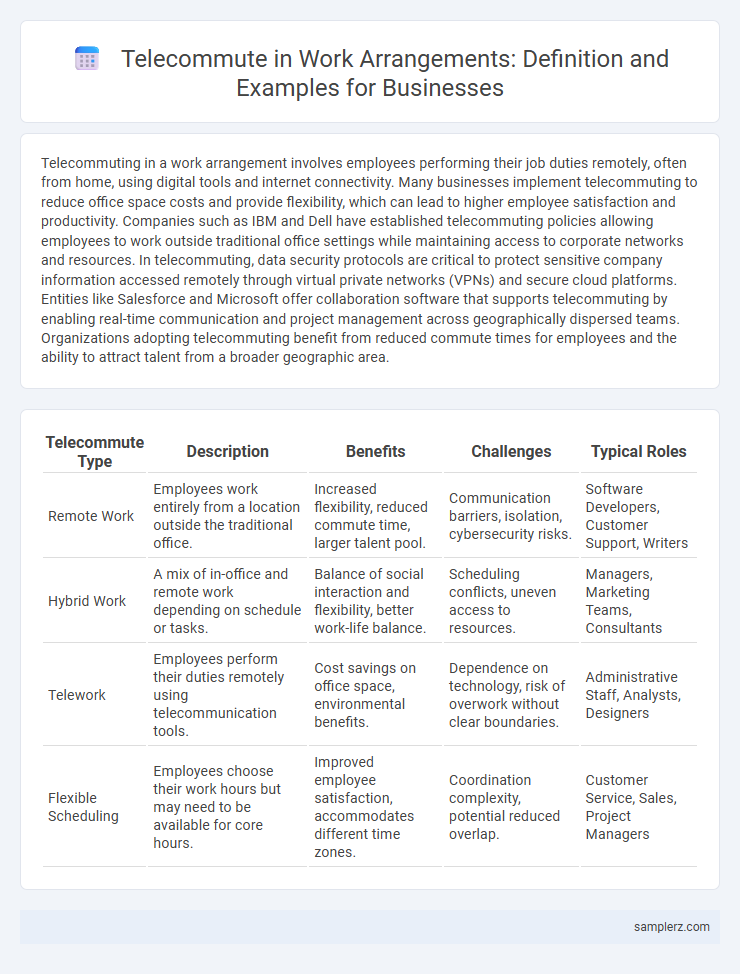Telecommuting in a work arrangement involves employees performing their job duties remotely, often from home, using digital tools and internet connectivity. Many businesses implement telecommuting to reduce office space costs and provide flexibility, which can lead to higher employee satisfaction and productivity. Companies such as IBM and Dell have established telecommuting policies allowing employees to work outside traditional office settings while maintaining access to corporate networks and resources. In telecommuting, data security protocols are critical to protect sensitive company information accessed remotely through virtual private networks (VPNs) and secure cloud platforms. Entities like Salesforce and Microsoft offer collaboration software that supports telecommuting by enabling real-time communication and project management across geographically dispersed teams. Organizations adopting telecommuting benefit from reduced commute times for employees and the ability to attract talent from a broader geographic area.
Table of Comparison
| Telecommute Type | Description | Benefits | Challenges | Typical Roles |
|---|---|---|---|---|
| Remote Work | Employees work entirely from a location outside the traditional office. | Increased flexibility, reduced commute time, larger talent pool. | Communication barriers, isolation, cybersecurity risks. | Software Developers, Customer Support, Writers |
| Hybrid Work | A mix of in-office and remote work depending on schedule or tasks. | Balance of social interaction and flexibility, better work-life balance. | Scheduling conflicts, uneven access to resources. | Managers, Marketing Teams, Consultants |
| Telework | Employees perform their duties remotely using telecommunication tools. | Cost savings on office space, environmental benefits. | Dependence on technology, risk of overwork without clear boundaries. | Administrative Staff, Analysts, Designers |
| Flexible Scheduling | Employees choose their work hours but may need to be available for core hours. | Improved employee satisfaction, accommodates different time zones. | Coordination complexity, potential reduced overlap. | Customer Service, Sales, Project Managers |
Introduction to Telecommuting in Business
Telecommuting in business allows employees to perform their job duties remotely, leveraging digital tools such as video conferencing, cloud storage, and project management software. Companies like IBM and Dell have successfully implemented flexible telecommute policies to enhance productivity and reduce overhead costs. This work arrangement promotes work-life balance while maintaining operational efficiency through real-time communication and collaboration platforms.
Types of Telecommuting Work Arrangements
Telecommuting work arrangements include full-time remote work, where employees operate exclusively from locations outside the traditional office, and hybrid models, which combine on-site presence with remote days to enhance flexibility. Another type involves flexible scheduling allowing staff to choose working hours that suit their productivity peaks while collaborating virtually. These arrangements leverage digital communication tools and cloud-based platforms to maintain team cohesion and operational efficiency.
Remote Customer Support Roles
Remote customer support roles exemplify telecommuting by enabling employees to manage client inquiries and resolve issues from home or any off-site location using digital communication tools such as chat platforms, email, and VoIP systems. These positions often require access to CRM software and real-time collaboration applications to maintain service quality and efficiency. Companies benefit from this arrangement by expanding talent pools and reducing overhead costs while providing flexible work environments that enhance employee satisfaction.
Virtual Project Management Practices
Virtual project management practices in telecommute work arrangements leverage cloud-based collaboration tools such as Asana, Trello, and Microsoft Teams to coordinate tasks and track progress in real-time. Effective use of video conferencing platforms like Zoom or Google Meet ensures continuous communication and swift resolution of project issues despite physical distance. Emphasizing transparent documentation and time zone management enhances productivity and accountability within remote teams.
Telecommuting for IT and Software Development
Telecommuting in IT and software development enables professionals to work remotely using digital collaboration tools like Slack, GitHub, and Zoom, enhancing productivity and flexibility. Companies such as GitLab and Automattic have successfully implemented fully remote work models, reducing overhead costs while accessing global talent pools. This approach supports agile development cycles and continuous integration processes, vital for modern software engineering workflows.
Online Marketing and Content Creation Teams
Online Marketing and Content Creation teams often telecommute by leveraging cloud-based collaboration tools like Slack, Trello, and Google Workspace to manage campaigns and editorial calendars efficiently. These remote teams use video conferencing platforms such as Zoom or Microsoft Teams for brainstorming sessions, ensuring real-time communication and creative alignment. By adopting asynchronous content reviews and analytics dashboards, they optimize workflow flexibility and maintain productivity across different time zones.
Cloud-Based Administrative Services
Cloud-based administrative services enhance telecommuting by enabling remote access to essential business functions such as payroll, scheduling, and document management. These services leverage platforms like Microsoft Office 365 and Google Workspace, allowing employees to collaborate and update records in real-time from any location. Implementing cloud solutions reduces the need for physical office space while increasing operational efficiency and data security in distributed work environments.
Telehealth and Remote Consulting Examples
Telehealth enables healthcare professionals to provide remote medical consultations using video conferencing and digital monitoring tools, improving patient access and convenience. Remote consulting in business allows experts to offer specialized advice and strategies through virtual meetings, reducing travel costs and expanding client reach. These telecommute models leverage advanced communication technologies to maintain productivity and collaboration without physical presence.
Benefits of Telecommuting for Businesses
Telecommuting reduces overhead costs by minimizing the need for physical office space and utilities, leading to significant savings for businesses. It enhances employee productivity and satisfaction by offering flexible work hours and reducing commute-related stress. Access to a broader talent pool enables companies to hire skilled professionals regardless of geographic location, fostering innovation and diversity in the workforce.
Best Practices for Effective Telecommuting
Setting clear expectations and regular communication channels enhances productivity in telecommuting arrangements. Utilizing project management tools like Asana or Trello ensures task tracking and accountability. Establishing dedicated workspaces and adhering to consistent schedules supports work-life balance and reduces burnout.

example of telecommute in work arrangement Infographic
 samplerz.com
samplerz.com